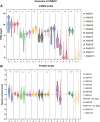Pathobiological functions and clinical implications of annexin dysregulation in human cancers
- PMID: 36247003
- PMCID: PMC9554710
- DOI: 10.3389/fcell.2022.1009908
Pathobiological functions and clinical implications of annexin dysregulation in human cancers
Abstract
Annexins are an extensive superfamily of structurally related calcium- and phospholipid-binding proteins, largely conserved and widely distributed among species. Twelve human annexins have been identified, referred to as Annexin A1-13 (A12 remains as of yet unassigned), whose genes are spread throughout the genome on eight different chromosomes. According to their distinct tissue distribution and subcellular localization, annexins have been functionally implicated in a variety of biological processes relevant to both physiological and pathological conditions. Dysregulation of annexin expression patterns and functions has been revealed as a common feature in multiple cancers, thereby emerging as potential biomarkers and molecular targets for clinical application. Nevertheless, translation of this knowledge to the clinic requires in-depth functional and mechanistic characterization of dysregulated annexins for each individual cancer type, since each protein exhibits varying expression levels and phenotypic specificity depending on the tumor types. This review specifically and thoroughly examines the current knowledge on annexin dysfunctions in carcinogenesis. Hence, available data on expression levels, mechanism of action and pathophysiological effects of Annexin A1-13 among different cancers will be dissected, also further discussing future perspectives for potential applications as biomarkers for early diagnosis, prognosis and molecular-targeted therapies. Special attention is devoted to head and neck cancers (HNC), a complex and heterogeneous group of aggressive malignancies, often lately diagnosed, with high mortality, and scarce therapeutic options.
Keywords: annexin; biomarker; diagnosis; head and neck cancer; therapeutic target.
Copyright © 2022 Prieto-Fernández, Menéndez, Otero-Rosales, Montoro-Jiménez, Hermida-Prado, García-Pedrero and Álvarez-Teijeiro.
Conflict of interest statement
The authors declare that the research was conducted in the absence of any commercial or financial relationships that could be construed as a potential conflict of interest.
Figures



Similar articles
-
Differential expression of annexins I, II and IV in human tissues: an immunohistochemical study.Histochem Cell Biol. 1998 Aug;110(2):137-48. doi: 10.1007/s004180050275. Histochem Cell Biol. 1998. PMID: 9720986
-
Annexin A1, A2, A5, and A6 involvement in human pathologies.Proteins. 2023 Sep;91(9):1191-1204. doi: 10.1002/prot.26512. Epub 2023 May 23. Proteins. 2023. PMID: 37218507 Review.
-
Genome-wide comparative analysis of annexin superfamily in plants.PLoS One. 2012;7(11):e47801. doi: 10.1371/journal.pone.0047801. Epub 2012 Nov 2. PLoS One. 2012. PMID: 23133603 Free PMC article.
-
Identification, phylogenetic relationships, characterization and gene expression patterns of six different annexins of channel catfish (Ictalurus punctatus Rafinesque, 1818).Vet Immunol Immunopathol. 2010 Jul;136(1-2):176-83. doi: 10.1016/j.vetimm.2010.02.013. Epub 2010 Feb 24. Vet Immunol Immunopathol. 2010. PMID: 20227769
-
Annexins in Translational Research: Hidden Treasures to Be Found.Int J Mol Sci. 2018 Jun 15;19(6):1781. doi: 10.3390/ijms19061781. Int J Mol Sci. 2018. PMID: 29914106 Free PMC article. Review.
Cited by
-
Lysine Acetylome of Breast Cancer-Derived Small Extracellular Vesicles Reveals Specific Acetylation Patterns for Metabolic Enzymes.Biomedicines. 2023 Apr 2;11(4):1076. doi: 10.3390/biomedicines11041076. Biomedicines. 2023. PMID: 37189694 Free PMC article.
-
Proteomics-Empowered Microfluidic-SERS Immunoassay for Identifying and Detecting Biomarkers of Micropapillary Lung Adenocarcinoma.Adv Sci (Weinh). 2025 Jul;12(25):e2501336. doi: 10.1002/advs.202501336. Epub 2025 May 3. Adv Sci (Weinh). 2025. PMID: 40318161 Free PMC article.
-
The multifaceted roles of mucins family in lung cancer: from prognostic biomarkers to promising targets.Front Immunol. 2025 Jun 27;16:1608140. doi: 10.3389/fimmu.2025.1608140. eCollection 2025. Front Immunol. 2025. PMID: 40655139 Free PMC article. Review.
-
Exploring the Impact of Biotic and Abiotic Surfaces on Protein Binding Modulation and Bacteria Attachment: Integrating Biological and Mathematical Approaches.ACS Nano. 2025 Jul 1;19(25):23393-23413. doi: 10.1021/acsnano.5c06573. Epub 2025 Jun 15. ACS Nano. 2025. PMID: 40518644 Free PMC article.
-
Relevance of Immunohistochemistry for Tumorigenic Tumor-Infiltrating Neutrophils and Reverse Polarity in Colonic Micropapillary Adenocarcinoma: A Case Report.Case Rep Pathol. 2025 Aug 4;2025:9365437. doi: 10.1155/crip/9365437. eCollection 2025. Case Rep Pathol. 2025. PMID: 40791825 Free PMC article.
References
-
- Álvarez-Teijeiro S., Menéndez S. T., Villaronga M. Á., Pena-Alonso E., Rodrigo J. P., Morgan R. O., et al. (2017a). Annexin A1 down-regulation in head and neck squamous cell carcinoma is mediated via transcriptional control with direct involvement of miR-196a/b. Sci. Rep. 7, 6790. 10.1038/s41598-017-07169-w - DOI - PMC - PubMed
-
- Álvarez-Teijeiro S., Menéndez S. T., Villaronga M. Á., Rodrigo J. P., Manterola L., De Villalaín L., et al. (2017b). Dysregulation of miR-196b in head and neck cancers leads to pleiotropic effects in the tumor cells and surrounding stromal fibroblasts. Sci. Rep. 7, 17785. 10.1038/s41598-017-18138-8 - DOI - PMC - PubMed
-
- Andey T., Marepally S., Patel A., Jackson T., Sarkar S., O’Connell M., et al. (2014). Cationic lipid guided short-hairpin RNA interference of annexin A2 attenuates tumor growth and metastasis in a mouse lung cancer stem cell model. J. Control. Release 184, 67–78. 10.1016/j.jconrel.2014.03.049 - DOI - PMC - PubMed
Publication types
LinkOut - more resources
Full Text Sources

